IAM History in Images
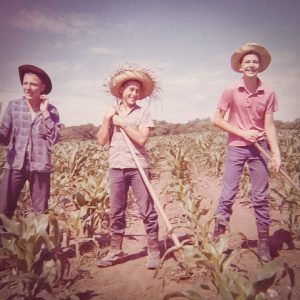
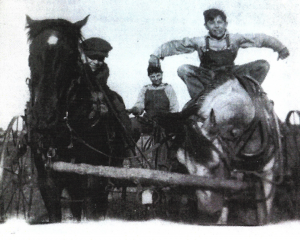
It comes from our “roots”. On the left; Hoeing corn on the Donham family farm near Iowa City, Iowa: From left to right, Kelley Donham age 12, and cousins Jeff Wombacher and Dan Potter ages 10 years. On the right is Clyde Berry circa age 10 riding on work horses on the family farm near the town of Posey, in Southern Illinois.
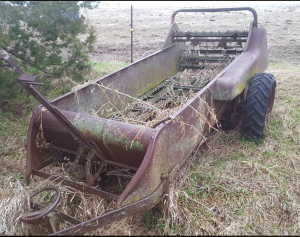
Manure spreader like the one Kelley Donham was driving when he ran over his dad causing a severe broken leg.
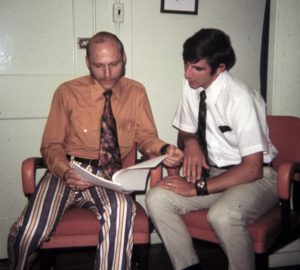
1964 – Kelley Donham and Tom Carson. Kelley was a research assistant and entering graduate student in the IAM. Tom Carson was a summer intern in the IAM, a student in Veterinary Medicine at Iowa State University. Carson went on to have a long career as a professor in Toxicology at the Iowa State College of Veterinary Medicine.
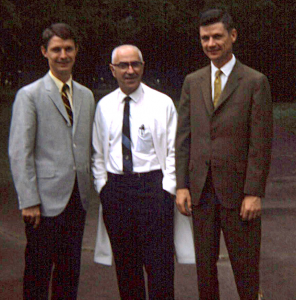
Circa 1966: William (Bill) McCulloch DVM, MPH On the right, Dr. Clyde Berry in the center, and Mike McCulloch MD on the left. The photo is on the occasion of Mike’s graduation from the U.I. College of Medicine. Bill went on to Direct the Comparative Section of the IAM and subsequently became Dean of the Oregon College of Veterinary Medicine. Mike went on to become a practicing psychiatrist and worked with brother Bill to establish the animal-human bond/pet therapy non profit organization now called Pet Partners.
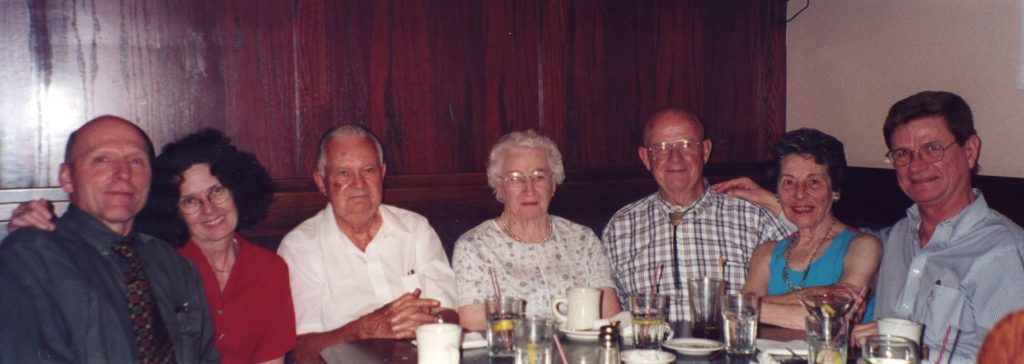
1999: From left to right – Donham and spouse Jean, Dr. Keith Long and wife Hazel; Pete Knapp and spouse Jackie, and Bill McCulloch. These photos were taken at the event I called when we started to plan to write the history of the IAM.
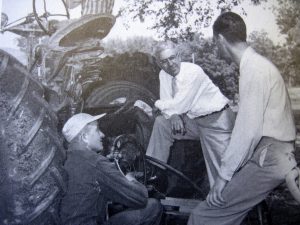
Circa 1962: Dr. Clyde Berry (center) consulting with a farmer on tractor safety.
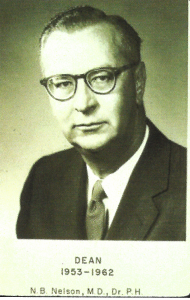
Circa 1955: U.I. College of Medicine Dean Norman V. Nelson MD MPH initiated contact with Kellogg Foundation to establish support for the founding of the IAM.
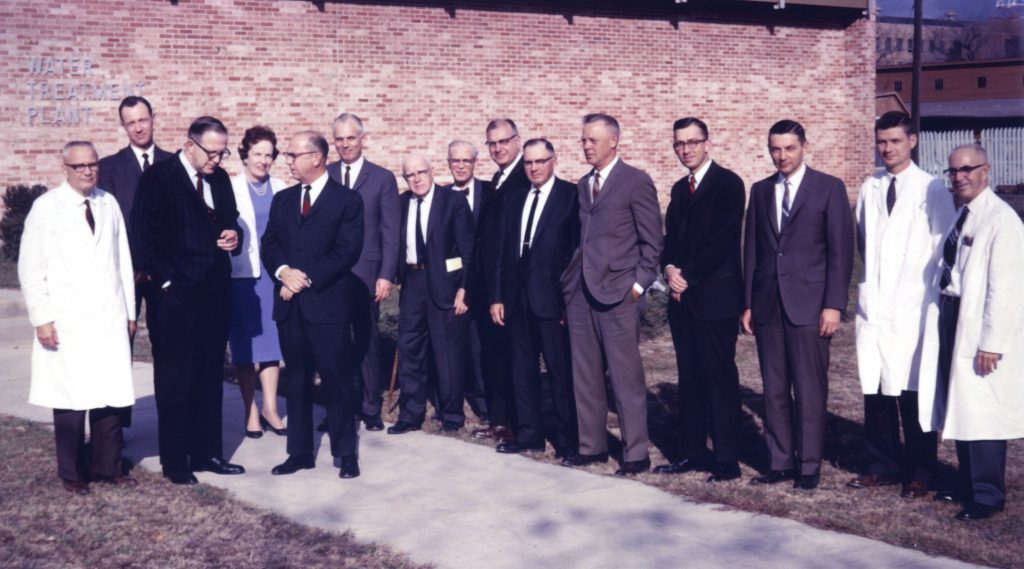
Circa 1960: The IAM Advisory Committee. I name only those I can certainly identify: Franklin Top MD, in white coat to the left. To Top’s left is Norman Nelson MD DrPH, Dean of the College of Medicine. To Nelson’s left is I.A. Merchant DVM, Dean College of Veterinary Medicine. On the right side of the photograph in order from right to left are Clyde Berry PhD and Bill McCulloch DVM PhD with white coats) followed by Derwood Baker DVM (Associate Dean, College of Veterinary Medicine). Tenth in line from the right is Stan Hendricks DVM (Iowa Dept. of Public Health).
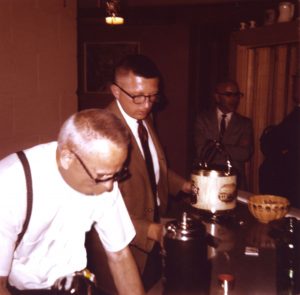
Circa 1964: Dr. Top in the foreground, with Dr. Paul Leaverton in the background. Paul was important in the early development of biostatistics in the DOEH. Paul later moved on to the University of South Florida and retired there as head of the Department of Epidemiology and Biostatistics.
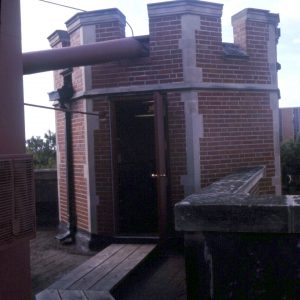
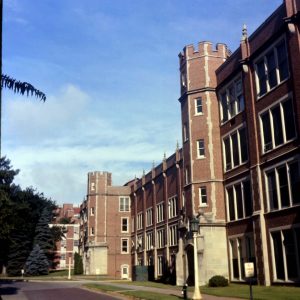
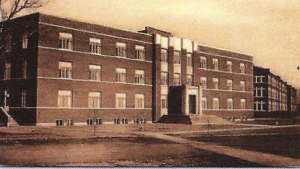
Circa 1965: In the early days, the IAM was scattered over several sites at the University. The old Medical Laboratory building and the “Mouse House” on top of the 5th floor of the old medical laboratory building (where experimentally infected toxoplasmosis mice were kept) were two prominent locations for IAM activities. However, The Oakdale Tuberculosis Hospital was seven miles from the main campus. Also, the U.I. Water Plant off Burlington Street near the Iowa River (not pictured) was a third locations for IAM activities before 1969.
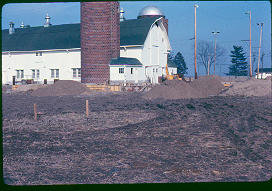
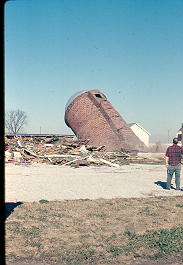 .
. 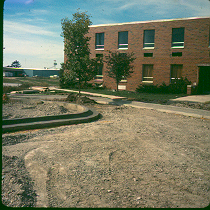
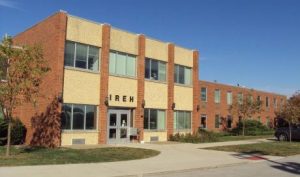
1965 – 1970: Gifts from the Kellogg Foundation allowed construction of a new building on the Oakdale Campus to house all sections of the IAM in one structure. This sequence of photos shows the destruction of the old farm buildings on the Oakdale Tuberculosis Hospital Campus to allow the construction of the new IAM building. The 250-cow capacity dairy barn was torn down and the IAM building was erected in its place, in two phases, completed in 1970.
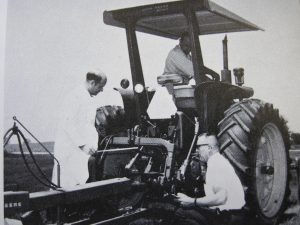 .
. 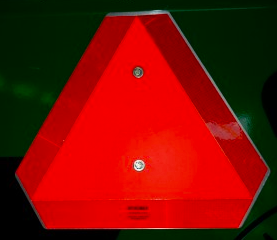
Pete Knapp (standing wearing white coat) working here with Bill McConnell (kneeling) a staff agricultural engineer). Pete worked to redesign the power take-off on tractors to prevent the severe often-fatal entanglements that have all too often happened on farms. Knapp also was a principal in the development of the now nationally recognized slow-moving vehicle sign (symbol on the right above). This sign is required in most states, on all vehicles which operate below 25 mph when operating on public roads.
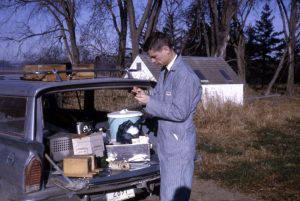
William (Bill) McCulloch DVM MPH was one of the founders of IAM. He directed the Infectious diseases section. His field and laboratory research led to defining the ecology of leptospirosis and toxoplasmosis, leading to increased diagnoses of clinical cases, proper treatment, and prevention of these diseases.
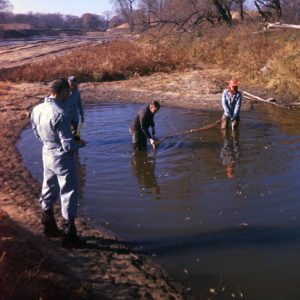
Water contaminated with urine from infected animals was found to be a major source of transmission of leptospirosis to people and other animals. This image depicts isolation attempts from a farm pond. Several leptospirosis outbreaks were investigated that involved people swimming in farm ponds.
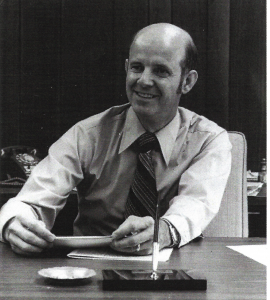
Lafayette (Pete) Knapp was one of the founding fathers of the IAM. He was director of the IAM following the retirement of Dr. Top and Dr. Berry. He directed the Injury Prevention Laboratory in the IAM and was active in an engineering and epidemiologic approach to injury prevention. In addition, he was very active in international organizations related to farmer and farm worker health and safety.
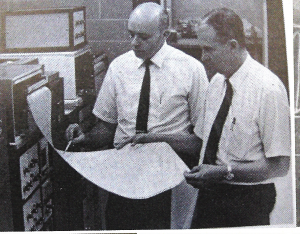
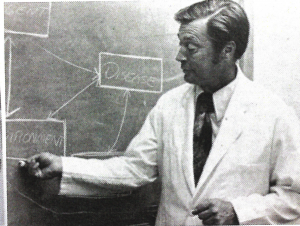
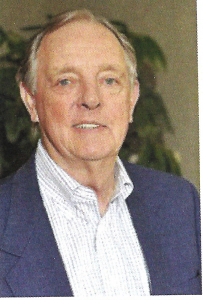
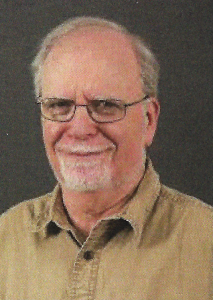
From 1952 – 1970, Dr. Franklin Top (not shown) was the Department Head of Preventive Medicine and Environmental Health (DPMEH) in the College of Medicine and founding IAM Director. Following him as Department Heads of DPMEH, Keith Long (1970-1972), to the right of Ed Slach, gas chromatograph technician) Peter Isaacson (1972-1985) Robert Wallace (1985-1994), Leon Brumeister, Interim (1995-1997), and James Merchant (1997-1999). Merchant led the transition of the DPMEH to the College of Public Health and was Dean of the College from 1999-2008.
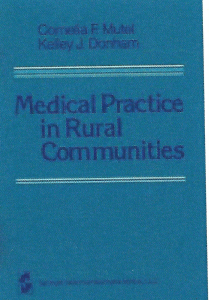
The first textbook in the field of Agricultural Medicine and its relevancy to rural medical practice was Medical Practice in Rural in Rural Communities (Mutel and Donham,1983) came as an effort to provide teaching materials for medical students and midlevel providers to study public health and rural medicine.
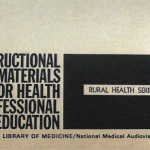 .
. 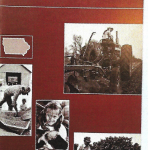
The Rural Health and Agricultural Medicine Education program of the IAM aimed to go national and Global. There was no other specific training in the World that we could find that aimed agricultural medicine at the health professions. Aimed for distance learning, The Rural Health Series included 16 units of slide-tapes covering occupational health concerns of farmers and their families. It was designed and produced by Donham, Connie Mutel, Carol Cain, Knapp, Larry Piercy and Don Morgan. It made available 20 hours of continuing medical or nursing education. The National Library of Medicine distributed it nationally and internationally. The RuralHealth and Safety Training Program targeted medical students and primary care providers to equip them with the knowledge and experiences that would prepare them to better serve farmers and their families.
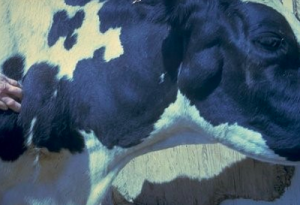
Bovine lymphosarcoma is the most common cancer in cattle (Note the lump on the jaw of the cow. It is lymphosarcoma involving the submandibular lymph nodes). Caused by a virus (bovine leukemia virus [BLV]) this virus is transmissible. As leukemia in farmers is generally of greater prevalence than the general population, we conducted animal studies of primates’ susceptibility to BLV.
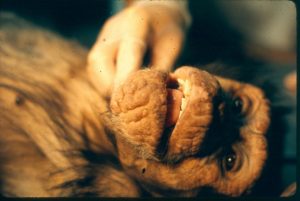
Although none of the primates developed frank lymphoma or leukemia, one chimpanzee developed leprosy (note the thickened lips, eyebrows, and nose).Thought for decades that leprosy this was only a human disease, this chimp is the first non-human animal other than armadillos known to contract the condition. This chimp likely harbored leprosy bacilli sub clinically and developed clinical disease due to damage to his immune system by the BLV. This event-demonstrated leprosy is a zoonotic disease and offered a new model to study the disease that effects over five million people around the world.

1975: Donham consulted with the veterinarian in this image (on the left) who was suffering from an undiagnosed cardiorespiratory issue. Working with the U.I. Medical College, this person was diagnosed with chronic bronchitis and asthma from breathing air contaminants in hog building. This was the index case uncovered by IAM scientists which led over 20 years of research leading to the now the well-known complex of conditions cause by organic dusts.
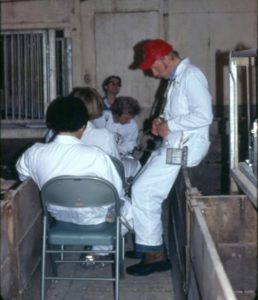 .
. 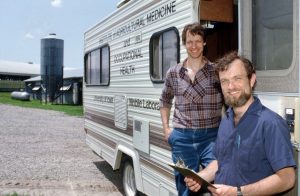
Early research Donham (pictured in the red hat) included clinically monitoring workers and volunteers in being in this environment, and more broadly in medical surveys of swine workers through Iowa with the use of a mobile clinic (health research technicians Wayne Johnson and Alan Weinrich on the right).
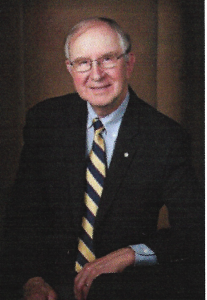
James Dosman MD founded in 1986, the Centre for Agricultural Medicine, University of Saskatchewan. The IAM served as a model and our faculty assisted Dosman by consulting for developing his center. Dr. Dosman is considered by many as the grandfather of agricultural medicine in Canada.
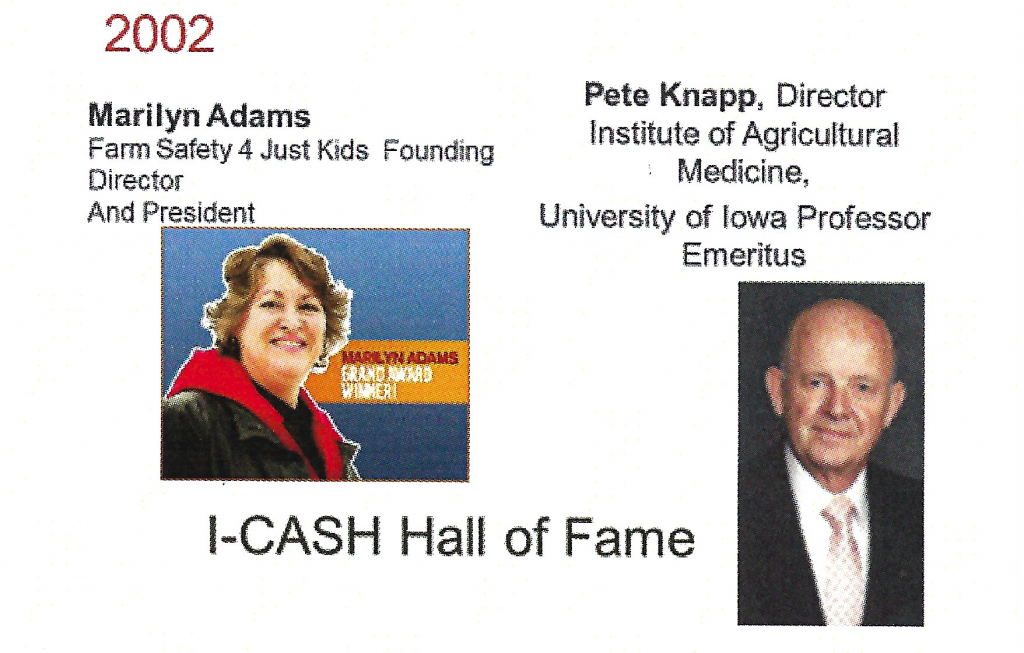
Marilyn Adams was a farm wife who lost her 10-year-old son in a farm accident. Out of her grief and intent to prevent such occurrences in the future, she began to tour grade schools, lecturing and demonstrating how to be safe on farms. During the development of the Agricultural at Risk Process, we donated $36,000 ($620,000 in 2020 dollars). This donation allowed Marilyn to quit her full time job and devote full time to her mission. She founded Farm Safety 4 Just Kids, which became an international voice for keeping kids safe on farms. Pictured above are Marilyn Adams and Pete Knapp who were honored by ICASH as inductees into the Iowa Agricultural Health and Safety Hall of Fame.

From 1986, the concept of the IAM began to shift from agriculture to a broader rural emphasis. In 1989 the name of the IAM unit and the facility was changed to the Institute for Rural Environmental Health (IREH as seen in letters over the main entrance).
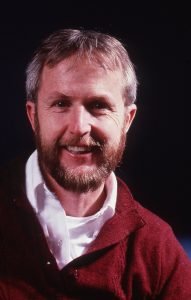
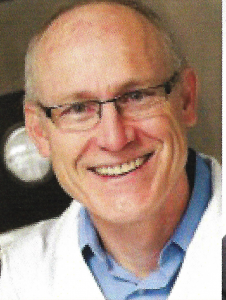
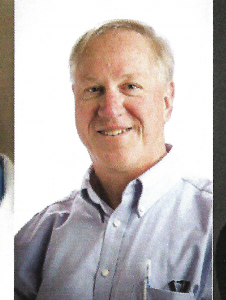
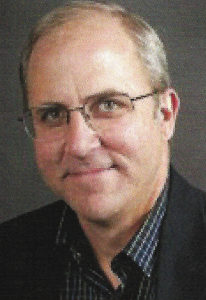
In the middle period of the IAM (1986 – 2005), several new faculty were added. William Popendorf PhD CIH, (1983), Peter Thorne PhD (1988) Steve Reynolds PhD CIH (1991), Patrick O’Shaughnessy PhD (1997). Not pictured include Mustafa Selim PhD, and Loren Will DVM MPH. As of 2021, Thorne, and O’Shaughnessy remain on the faculty; the others have moved to other opportunities.
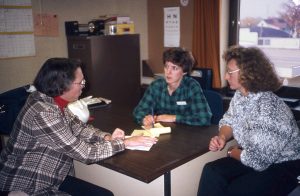
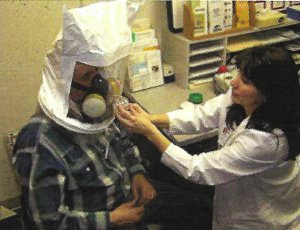
In 1986, the IAM founded a program called the Iowa Agricultural Health and Safety Service Network (IAHSSN). This program included a network of comprehensive occupational health and safety service programs for farmers. These were located and managed locally at rural hospitals and rural county public health departments. Jane Gay BSN (left) was the first staff coordinator for this program. In this photo, she discusses the program with Pam Delegardelle BSN of Sartori Hospital in Waterloo (left center) and Marsha Barrett BSN, Marshalltown Hospital (top right). Delegardelle and Barrett were the local managers of the program in their respective hospitals. They were the first two hospitals to join the program. Nurse Gay developed the protocols for the eventual 22 clinics that adopted the program (see map below). In 1992 (adopting the name coined by the IHASSN program in Spencer, Iowa.Carolyn Sheridan BSN (Spencer, Iowa) managed the third program to come into the network at Spencer Community Hospital. the name of IHASSN was changed to the AgriSafe Network adopted from the name of the Spencer program. The AgriSafe Network became a program of Iowa’s Center for Agricultural Health and Safety (I-CASH) in 1990. In 1992 Natalie Roy MPH (left below) was an ICASH employee and became the coordinator of the program following the departure of Jane Gay in 1991. In 2003, AgriSafe transitioned to an independent non-profit organization, which is now a program of national and international scope. Natalie Roy became the Executive Director of the organization.
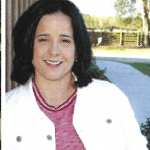
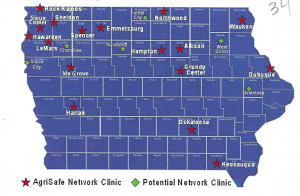
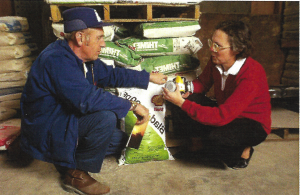
Jane Gay BSN was important in our out-reach education programs. In the photo above, she demonstrates the proper selection and use of respirators to a farmer. Jane also was our coordinator of an $11 million grants program of agricultural health and safety grants we received from the Kellogg Foundation.
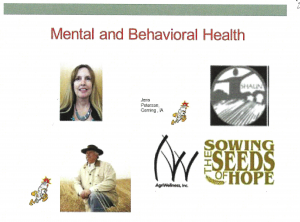
Mental health issues have always been of concern for farmers because of the stress inherent in farming. The IAM and ICASH were critical in assisting the development of two organizations to address this problem. In 1999, Jeris Peterson a farm wife developed the organization Sharing Help United Awareness (SHAUN) to assist families who have lost a member to a farm accident. In 2001, Michael Rosman PhD (farmer and clinical psychologist) took the mental health issue to the next level, founding Agriwellness.
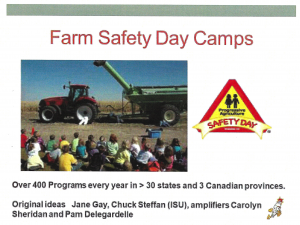
The concept of Farm Safety Day Camps began with the faculty and staff of I-CASH (circa 1990). Jane Gay BSN and Chuck Steffen (Iowa State graduate student at the time in agricultural engineering) developed the concept and produced an operations manual for the program. Our AgriSafe Network nurses, Carolyn Sheridan and Pam Dellegardelle advanced the operations manual and coordinated it as a regular program of ICASH and its AgriSafe network. In 1998, the Iowa Farm Safety Day Camp Program became a part of the Progressive Farmer Farm Safety Day Camp® program, which was funded in part by a foundation formed by Progressive Farmer Magazine in 1996. In 2006, the program became independent from Progressive Farmer Magazine, and operated under the Progressive Agriculture Foundation. The Program has impacted well over 1.5 million children and parents in the U.S. Canada, and several countries in South America and Europe.
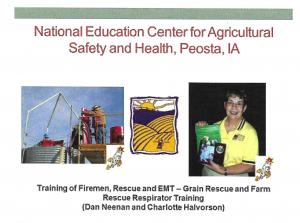
The National Education Center for Agricultural Safety (NECAS) was founded circa 1995, with cooperation and facilitation of ICASH. Pictured below is Charlotte Halvorson BSN, who was also an AgriSafe nurse, but also began working with NECAS. This joint work demonstrates the collaboration that was practiced by the IAM and ICASH.
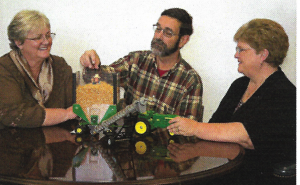
Pictured (from right to left) are Robin Tutor-Marcom PhD, LaMar Grafft MS, and Anette Greer PhD. Tutor-Marcom is the Director of the East Carolina Agromedicine Institute, Greer and Grafft are principal staff. Donham worked with the University of East Carolina beginning in 1987 to develop this Institute. Under Tutor-Marcom’s direction, this center is now one of the leading centers in the U.S. in health and safety outreach to their Agricultural community.
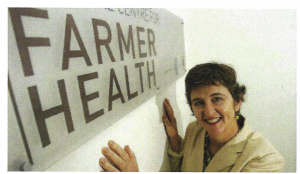
Sue Brumby BSN, MS, PhD directs the Australian Center for Farmers Health. She attended the Agricultural Health and Safety Core Course here in Iowa and spent sabbatical time here as well. Donham worked with her in the forming stages for their inaugural “Opening the Gate to Farmers Health Conference” held in October 2010 to help develop their program. In 2006, Brumby took the Iowa Agricultural Health and Safety Core Course and introduced it in Australia (Brumby, Rudolphi, Rohlman, Donham 2017).
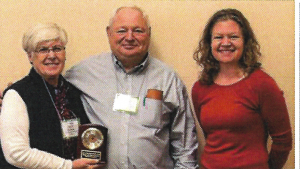 .
. 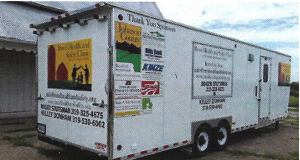
Rural Health and Safety of Eastern Iowa (RHSEI) was founded 2011 in Johnson County, Iowa by Roger Stutsman and Kelley Donham. A tragic event which helped to bring this organization to fruition was the loss of the son of Roger and Sally Stusman to a farm accident. A feature of RHSEI is a partnership with Mercy Hospital which has assisted deploying the RHSEI mobile clinic for health screening and health and safety education. Pictured on the left are Roger, wife Sally being presented the ICASH Hall of Fame Award from Brandi Janssen, I-CASH Director.
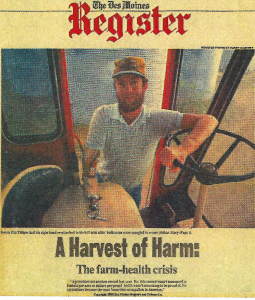
In 1984, Tom Knutson, an investigative reporter for the Des Moines Register, wrote a series of articles titled “A Harvest of Harm” that helped propel the issue of agriculture health and safety to a broad public awareness. He received a Pulitzer Prize for this series. IAM faculty were critical consultants to Knutson in his research for these articles.
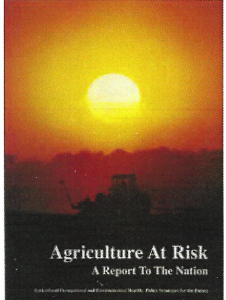
In 1988, a strategic plan was launched to bring awareness to policy makers and the public that the health and safety of our farmers was a major public health issue. Donham founded and chaired the ad hoc organization “National Coalition for Agricultural Health and Safety (NCASH)” to manage the guide the issue. The groundbreaking report (“Agriculture and Risk: A Report to the Nation”) helped drive the issue as it was produced and widely disseminated, resulting in the Surgeon Generals conference, congressional action, and a $24 million annual allocation to form the CDC NIOSH Agricultural Health and Safety Program. Merchant, Donham, Burton Kross (not pictured), and David Pratt (not pictured) authored the report. Cornelia Mutel (not pictured) was the technical editor of the document.
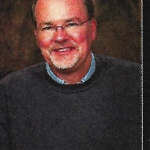
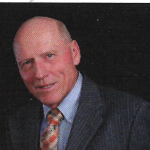
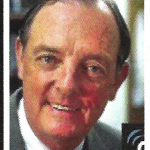
Kendall Thu PhD (left above), Associate Director of ICASH worked with Donham (center above) developing the strategic plan. Dr. Jim Merchant (right above) acquired backing and support of NIOSH to move this issue forward.
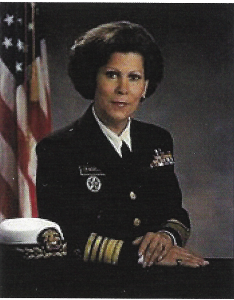
The series of articles “Harvest of Harm” in the Des Moines Register, and the Agriculture and Risk Policy Process, led to action on the national level. The Surgeon General at the time (Antonia Novello called for a national conference on the issue of farm health and safety. In 1992, the conference “FarmSafe 2000: A National Coalition for Local Action” was held in Des Moines, Iowa.
To: Bibliography

